warning lights CHEVROLET ASTRO PASSENGER 1993 1.G Owners Manual
[x] Cancel search | Manufacturer: CHEVROLET, Model Year: 1993, Model line: ASTRO PASSENGER, Model: CHEVROLET ASTRO PASSENGER 1993 1.GPages: 345, PDF Size: 19 MB
Page 11 of 345

Downloaded from www.Manualslib.com manuals search engine These symbols have to do with your lights:
0
Master Lighting
Switch Turn
Signal
Direction
Parking Lights
Fog Lights
A
Hazard Warning
Flasher
Daytime
Running Lights Headlight
High Beam
~
These symbols are on some of your controls:
Hood Release Windshield
Wper
Ventilating Fan Windshield
Washer Windshield
Defroster
Rear Window
Wiper
L? Washer Rear Window
Defogger Hatch
Release
PO358
0-5
Page 12 of 345

Downloaded from www.Manualslib.com manuals search engine These symbols are used on warning and indicator lights:
Engine Coolant
Temperature
BRAKE
Brake
(Standard Cluster) mrtery
Charging
System
I
ANTI-
LOCK
Four- Wheel
Anti-lock Brakes
Fuse Fuel
1
Engine Oil
Pressure
Here are some
other symbols you may see:
Lighter Horn Speaker
PO359
Page 58 of 345

Downloaded from www.Manualslib.com manuals search engine Features & Controls
Shifting Into P (Park) ........................................................................\
.................. 2-21
Shifting Out
of P (Park) ........................................................................\
............. 2-23
Parking Over Things That Burn
........................................................................\
. 2-23
Engine Exhaust
........................................................................\
........................... 2-24
Running Your Engine While You’re Parked
.................................................. 2-25
Windows
........................................................................\
....................................... 2-26
Horn
........................................................................\
.............................................. 2-28
Tilt Wheel
........................................................................\
..................................... 2-28
Turn Signal/MuItifunction Lever
........................................................................\
.. 2-29
Turn Signal and Lane Change Indicator
....................................................... 2-30
Headlight High-Low Beam
........................................................................\
...... 2-31
Windshield Wipers
........................................................................\
................... 2-32
Windshield Washer
........................................................................\
.................. 2-33
Rear Window WiperNVasher
........................................................................\
... 2-34
Cruise Control
........................................................................\
.......................... 2-35
Lights
........................................................................\
............................................ 2-40
Mirrors
........................................................................\
.......................................... 2-45
Sun Visors
........................................................................\
................................... 2-48
Luggage Carrier
........................................................................\
........................... 2-49
Cigarette Lighter/Ashtrays
........................................................................\
........... 2-50
Storage Compartments
........................................................................\
............... 2-51
Instrument Cluster
........................................................................\
....................... 2-52
Warning Lights, Gages and Indicators
.......................................................... 2-57
Indicator Lights
........................................................................\
......................... 2-64
Trailer Wiring Harness
........................................................................\
................ 2-67
Assist Handles
........................................................................\
............................. 2-68
2-2
Page 98 of 345

Downloaded from www.Manualslib.com manuals search engine Features & Contmls
PO396
Use your optional fog lamps for better vision in foggy or misty conditions.
Your parking lights and/or low beam headlights must be on or your fog lamps
won't work.
Your fog lamp switch
is in the center of the instrument panel above the radio.
Slide the right side
of the switch to turn the fog lamps on, and the left side
of the switch to turn them
off. A warning light in the switch will remind you
that your fog lights are
on.
Remember, fog lamps alone will not give off as much light as your headlights.
Never use your fog lamps in the dark without turning on your headlights.
Fog lamps will go
off whenever your high beam lights come on. When the
high beams go
off, the fog lamps will come on again.
2-42
Page 113 of 345
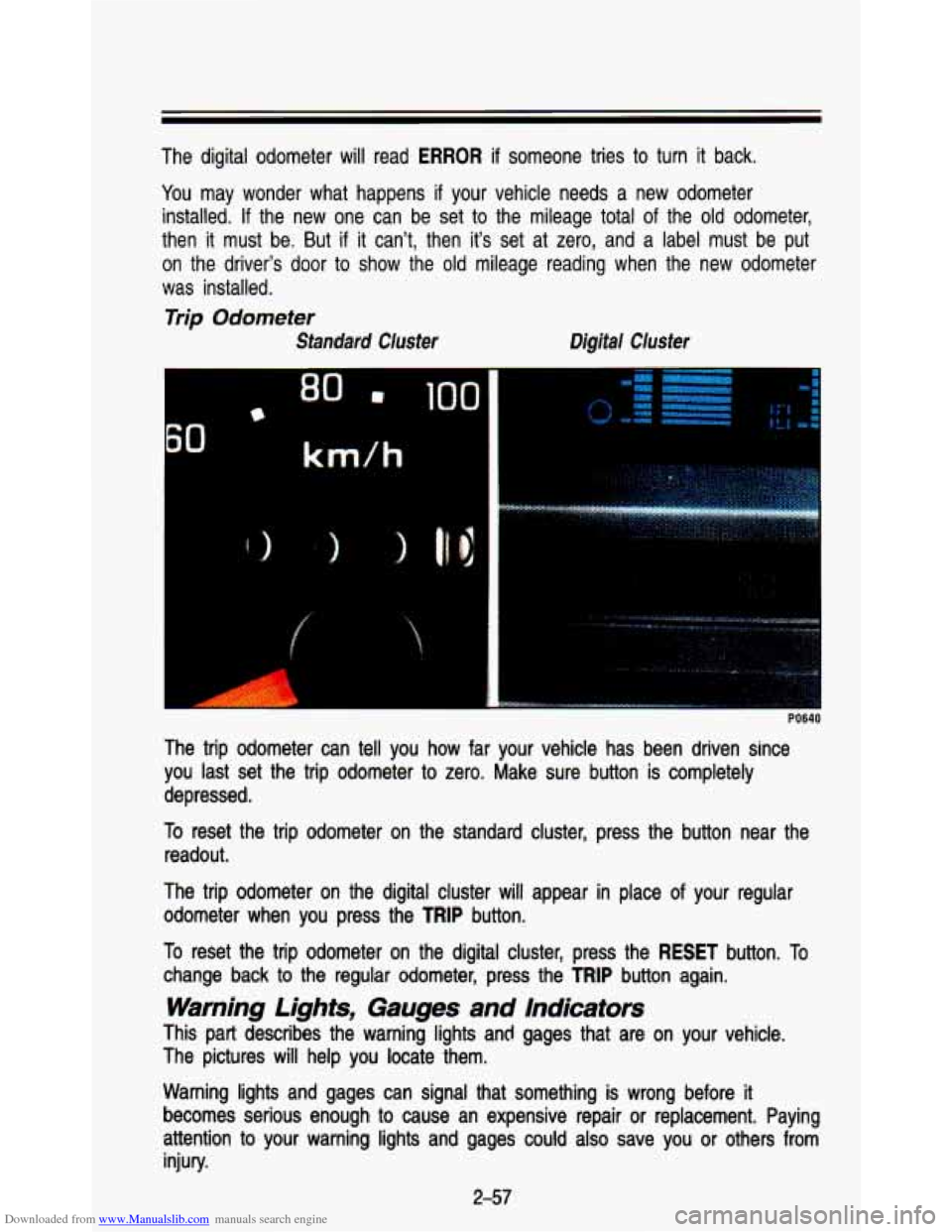
Downloaded from www.Manualslib.com manuals search engine The digital odometer will read ERROR if someone tries to turn it back.
You may wonder what happens
if your vehicle needs a new odometer
installed.
If the new one can be set to the mileage total of the old odometer,
then it must be. But if it can’t, then it’s set at zer\
o, and a label must be put
on the driver’s door to show the old mileage reading when the \
new odometer
was installed.
Trip Odometer
Standard Cluster Digital Cluster
km/h
t
PO640
The trip odometer can tell you how far your vehicle has been driven since
you last set the trip odometer to zero. Make sure button is completely
depressed.
To reset the trip odometer on the standard cluster, press the but\
ton near the
readout.
The trip odometer on the digital cluster
will appear in place of your regular
odometer when you press the
TRIP button.
To reset the trip odometer on the digital cluster, press the
RESET button. To
change back to the regular odometer, press the
TRIP button again.
Warning Lights, Gauges and Indicators
This part describes the warning lights and gages that are on your vehicle.
The pictures
will help you locate them.
Warning lights and gages can signal that something is wrong before it
becomes serious enough to cause an expensive repair or replacement. Paying
attention to your warning lights and gages could also save you or other\
s from
injury.
2-57
Page 114 of 345
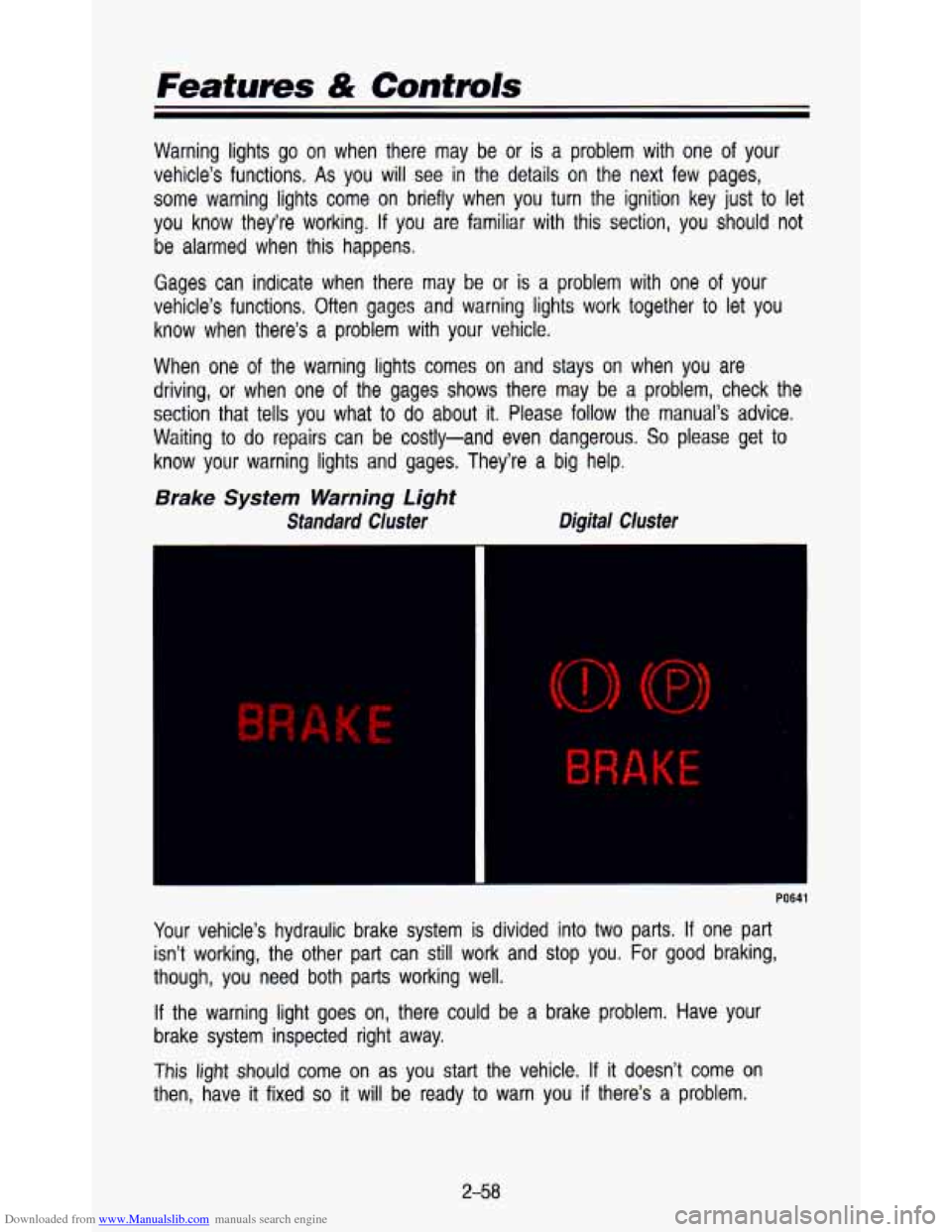
Downloaded from www.Manualslib.com manuals search engine Features & Contmls
Warning lights go on when there may be or is a problem with one of your
vehicle’s functions.
As you will see in the details on the next few pages,
some warning lights come on briefly when you turn the ignition\
key just to let
you know they’re working.
If you are familiar with this section, you should not
be alarmed when this happens.
Gages can indicate when there may be
or is a problem with one of your
vehicle’s functions. Often gages and warning lights work toge\
ther to let you
know when there’s
a problem with your vehicle.
When one
of the warning lights comes on and stays on when you are
driving, or when one
of the gages shows there may be a problem, check the
section that tells you what to
do about it. Please follow the manual’s advice.
Waiting to
do repairs can be costly-and even dangerous. So please get to
know your warning lights and gages. They’re
a big help.
Brake System Warning Light
Standard Cluster Digital Cluster
K E
Your
vehicle’s hydraulic brake system is divided into two parts. If one part
isn’t working, the other part can still work and stop you. \
For
good braking,
though, you need both parts working well.
If the warning light goes on, there could be a brake problem. Have your
brake system inspected right away.
This
light should come on as you start the vehicle. If it doesn’t come on
then, have
it fixed so it will be ready to warn you if there’s a problem.
2-58
Page 120 of 345
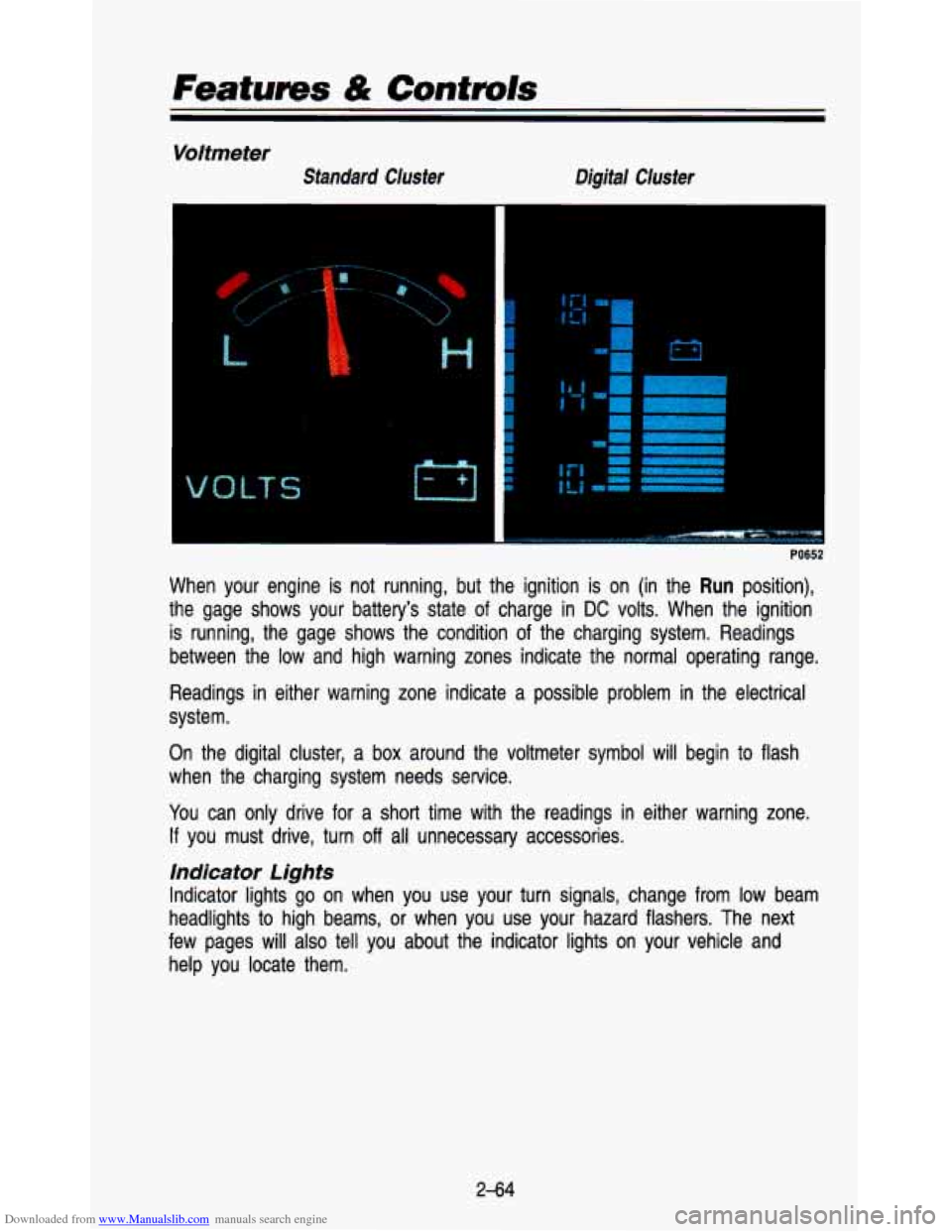
Downloaded from www.Manualslib.com manuals search engine Featurns & Controls
Voltmeter
Standard Cluster Digital Cluster
r
LT S M
I
i
f
r
I
'i I I
I
I I I
PO652
When your engine is not running, but the ignition is on (in \
the Run position),
the gage shows your battery's state
of charge in DC volts. When the ignition
is running, the gage shows the condition of the charging syste\
m. Readings
between the low and high warning zones indicate the normal ope\
rating range.
Readings in either warning zone indicate a possible problem in the electric\
al
system.
On the digital cluster,
a box around the voltmeter symbol will begin to flash
when the charging system needs service.
You can only drive for a
short time with the readings in either warning zone.
If you must drive, turn off all unnecessary accessories.
indicator Lights
Indicator lights go on when you use your turn signals, change \
from low beam
headlights to high beams,
or when you use your hazard flashers. The next
few pages
will also tell you about the indicator lights on your vehicle and
help you locate them.
2-64
Page 162 of 345
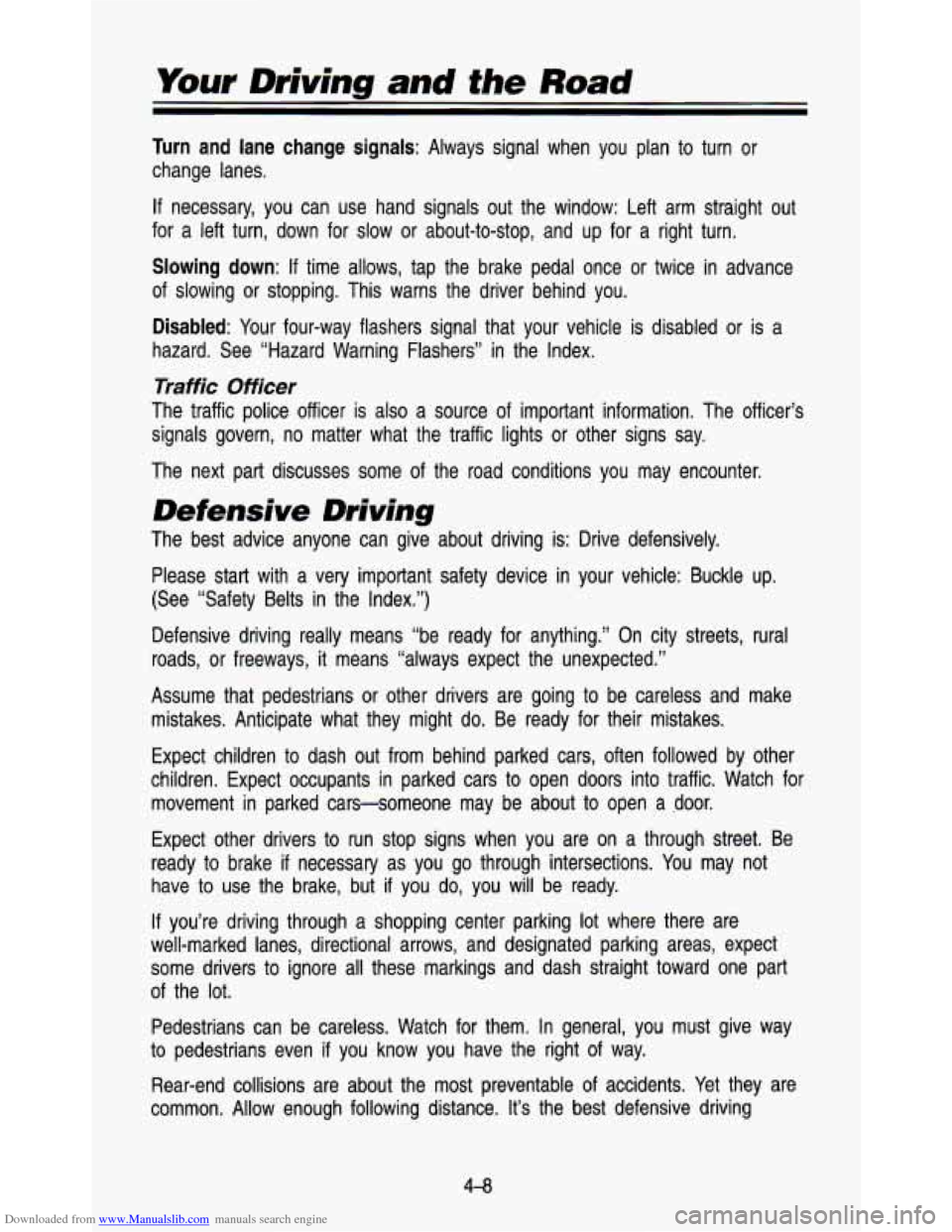
Downloaded from www.Manualslib.com manuals search engine Your Driving and the Road
Turn and lane change signals: Always signal when you plan to turn or
change lanes.
If necessary, you can use hand signals out the window: Left arm \
straight out
for a left turn, down for slow or about-to-stop, and up for \
a right turn.
Slowing down: If time allows, tap the brake pedal once or twice in advance
of slowing or stopping. This warns the driver behind you.
Disabled: Your four-way flashers signal that your vehicle is disabled or is a\
hazard. See “Hazard Warning Flashers” in the Index.
Traffic Officer
The traffic police officer is also a source of important information. The officer’s
signals govern, no matter what the traffic lights or other sig\
ns say.
The next part discusses some of the road conditions you may encounter.
Defensive Driving
The best advice anyone can give about driving is: Drive defens\
ively.
Please start with a very important safety device in your vehic\
le: Buckle up.
(See “Safety Belts in the Index.”)
Defensive driving really means “be ready for anything.’’\
On city streets, rural
roads, or freeways, it means “always expect the unexpected.”
Assume that pedestrians or other drivers are going to be carel\
ess and make mistakes. Anticipate what they might
do. Be ready for their mistakes.
Expect children
to dash out from behind parked cars, often followed by other
children. Expect occupants in parked cars
to open doors into traffic. Watch for
movement in parked cars-someone may be about
to open a door.
Expect other drivers
to run stop signs when you are on a through street. Be
ready to brake if necessary as you go through intersections. You may not
have to use the brake, but
if you do, you will be ready.
If you’re driving through a shopping center parking lot where t\
here are
well-marked lanes, directional arrows, and designated parking are\
as, expect
some drivers to ignore all these markings and dash straight to\
ward one part
of the lot.
Pedestrians can be careless. Watch for them. In general, you m\
ust give way
to pedestrians even
if you know you have the right of way.
Rear-end collisions are about the most preventable of accidents. Yet they are
common. Allow enough following distance.
It’s the best defensive driving
4-0
Page 177 of 345
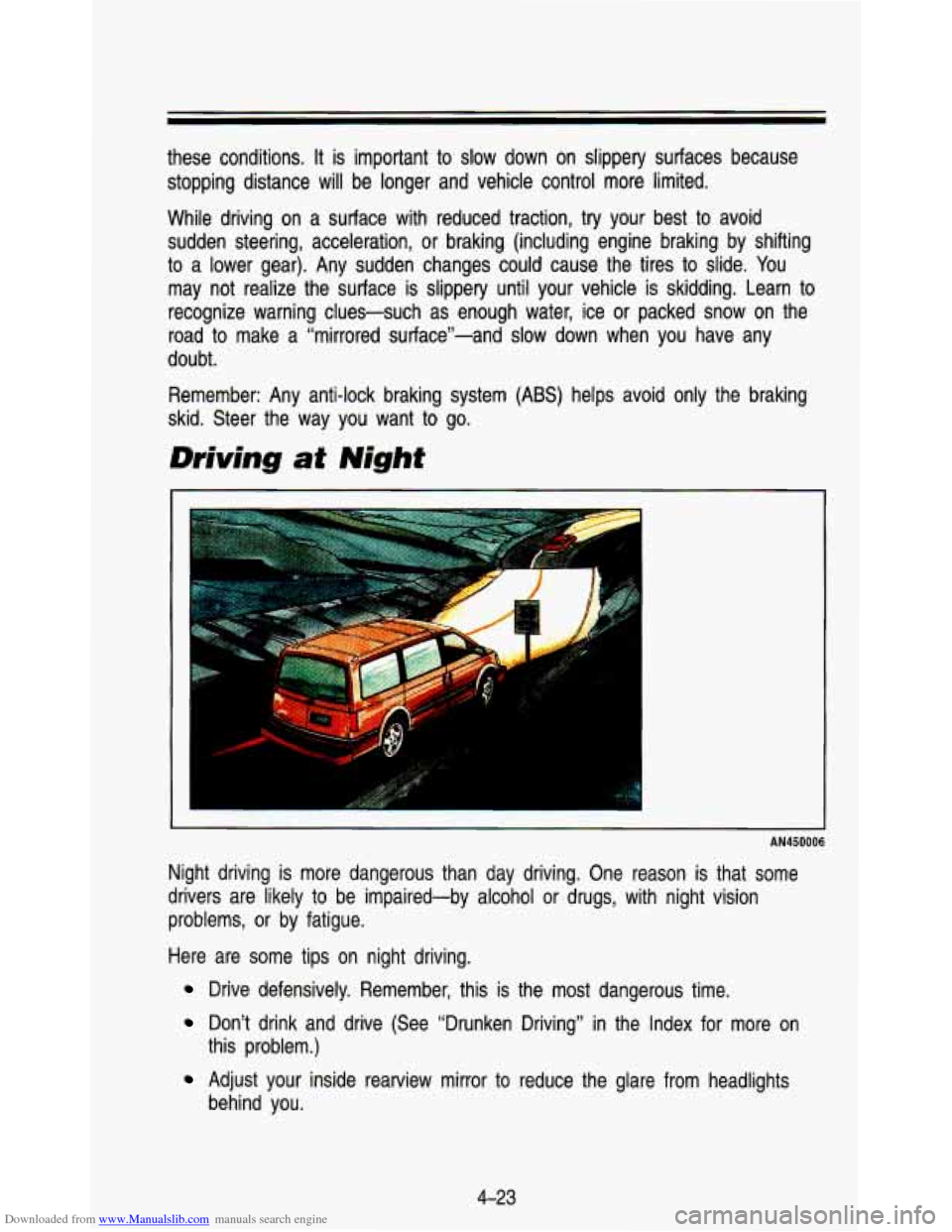
Downloaded from www.Manualslib.com manuals search engine these conditions. It is important to slow down on slippery surfaces because
stopping distance will be longer and vehicle control more limited.
While driving on a surface with reduced traction, try your best to avoid
sudden steering, acceleration, or braking (including engine brak\
ing by shifting
to a lower gear). Any sudden changes could cause the tires to s\
lide. You
may not realize the surface is slippery until your vehicle is skidding. Learn to
recognize warning clues-such as enough water, ice or packed sno\
w on the
road to make a “mirrored sutface”-and slow down when you have any\
doubt.
Remember: Any anti-lock braking system
(ABS) helps avoid only the braking
skid. Steer the way you want to go.
Driving at Night
AN450006
Night driving is more dangerous than day driving. One reason is that some
drivers are likely to be impaired-by alcohol or drugs, with night vision
problems, or by fatigue.
Here are some tips on night driving.
Drive defensively. Remember, this is the most dangerous time.
Don’t drink and drive (See “Drunken Driving” in the Index for more on
Adjust your inside rearview mirror to reduce the glare from he\
adlights
this problem.)
behind you.
4-23
Page 183 of 345
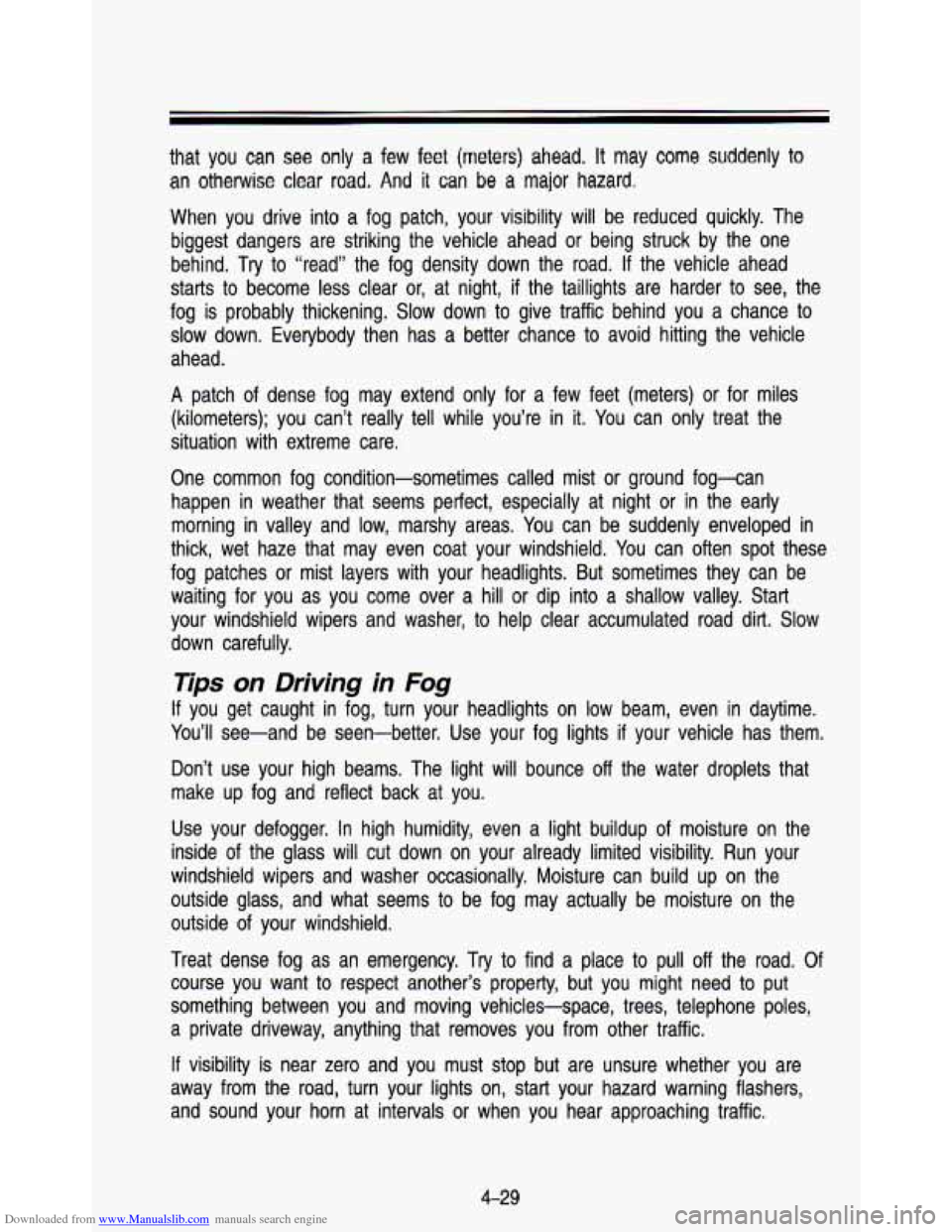
Downloaded from www.Manualslib.com manuals search engine that you can see only a few feet (meters) ahead. It may come suddenly to
an otherwise clear road. And it can be a major hazard.
When you drive into a fog patch, your visibility will be ieduced quickly. The
biggest dangers are striking the vehicle ahead
or being struck by the one
behind. Try
to “read” the fog density down the road. If the vehicle ahead
starts
to become less clear or, at night, if the taillights are harder to see, the
fog is probably thickening. Slow down to give traffic behind y\
ou a chance
to
slow down. Everybody then has a better chance to avoid hitting the vehicle
ahead.
A patch of dense fog may extend only for a few feet (meters) or for miles
(kilometers); you can’t really tell while you’re in
it. You can only treat the
situation with extreme care.
One common fog condition-sometimes called mist
or ground fog-can
happen in weather that seems perfect, especially at night
or in the early
morning in valley and low, marshy areas. You can be suddenly enveloped in
thick, wet haze that may even coat your windshield. You can often spot these
fog patches
or mist layers with your headlights. But sometimes they can be
waiting for you as you come over a hill
or dip into a shallow valley. Start
your windshield wipers and washer,
to help clear accumulated road dirt. Slow
down carefully.
Tips on Driving in Fog
If you get caught in fog, turn your headlights on low beam, even\
in daytime.
You’ll see-and be seen-better. Use your fog lights
if your vehicle has them.
Don’t use your high beams. The light will bounce
off the water droplets that
make up fog and reflect back at you.
Use your defogger. In high humidity, even a light buildup of moisture on the
inside
of the glass will cut down on your already limited visibility. Ru\
n your
windshield wipers and washer occasionally. Moisture can build up\
on the outside glass, and what seems to be fog may actually be moist\
ure on the
outside of your windshield.
Treat dense fog as an emergency.
Try to find a place to pull off the road. Of
course you want
to respect another’s property, but you might need to put
something between you and moving vehicles-space, trees, telephone poles,
a private driveway, anything that removes you from other traffi\
c.
If visibility is near zero and you must stop but are unsure whether you are
away from the road, turn your lights on, start your hazard warning flashers,
and sound your horn at intervals
or when you hear approaching traffic.
4-29